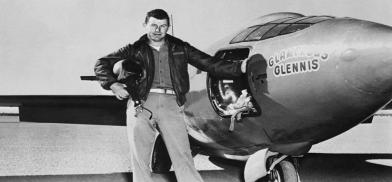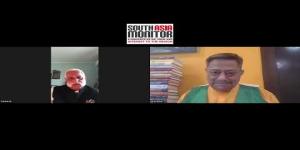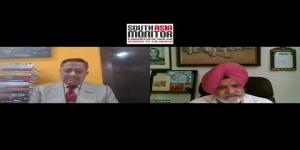Chuck Yeager: Aviation legend who batted for the Pakistan Air Force
In the course of his advisory duties, Yeager had made good friends in the higher echelons of the Pakistan Air Force (PAF), and within a short period, he fell prey to an affliction, known, amongst diplomats, as ‘localitis,’ i.e, a deep sympathy, verging on identification, with the host country and its people, writes Admiral Arun Prakash (retd) for South Asia Monitor

The 79th anniversary of Japan’s surprise attack on Pearl Harbour on December 7, 2020, also saw the sad demise of US Air Force Brigadier-General Charles ‘Chuck’ Elwood Yeager, aged 97. An outstanding military aviator and test pilot, Yeager’s name has already found a prominent place in the US Aviation Hall of Fame, alongside other legends like the Wright Brothers, Charles Lindbergh and Amelia Earhart, for his role in many epic events in aviation history.
From the US backwoods to becoming aviation legend
According to the New York Times, “Yeager came out of the West Virginia backwoods, with only a high school education and with a drawl that left many a fellow pilot bewildered. The first time he went up in a plane, he was sick to his stomach.”
Yeager enlisted as a Private in the US Army Air Corps in 1941 and entered pilot training to graduate two years later as a flight officer. During World War II, he flew 56 combat missions, in which he shot down 12 German aircraft. Returning to the USA in 1945, his remarkable flying skills got him a coveted berth in the USAF Test Pilot School.
On graduation, Yeager was selected as project pilot for one of the most important flight test programmes in history; to fly the rocket-powered Bell X-1.
First pilot to shatter sound barrier
In a historic event for aviation, on October 4, 1947, after launch from the belly of a B-29, the 24 year-old Chuck accelerated to Mach 1.06 at 42,000 feet and became the first pilot to shatter the once dreaded ‘sound barrier.’ He had reached a speed of 700 miles an hour, breaking the sound barrier and dispelling the long-held fear that any plane flying at or beyond the speed of sound would be torn apart by shock waves.
After commanding the USAF Test Pilot School and flying 127 missions over Vietnam, Yeager was promoted to Brigadier-General. In this rank, he was sent as the head of the Military Assistance Advisory Group (MAAG), to the US embassy in Islamabad, in 1971. That is how Yeager acquired a ‘South Asia connection,’ and our paths crossed, very briefly.
The 1971 war
In 2007, an Indian journalist sent me a Washington Monthly article of October 1985, titled, “The Right Stuff in the Wrong Place” by former US diplomat, Edward Ingraham, who had served as political counselor in the US Embassy in Islamabad, alongside Brig-Gen Yeager during the 1971 war.
Since I had also participated in the 1971 war while serving, on deputation with the Indian Air Force (IAF), I read the article with considerable interest and was startled by it's content.
According to Ingraham, in the course of his advisory duties, Yeager had made good friends in the higher echelons of the Pakistan Air Force (PAF), and within a short period, he fell prey to an affliction, known, amongst diplomats, as ‘localitis,’ i.e, a deep sympathy, verging on identification, with the host country and its people.
Ingraham provides a persuasive example. When asked, by the American ambassador for his assessment of how long the Pakistani forces in the East could last out against India, Yeager replied, “We could hold them off for maybe a month.” The embassy staff was horrified when they realized that by “us” Yeager, earnestly, meant West Pakistan, not the USA!
One of the perks of Yeager’s position was a twin-engined Beechcraft, a small airplane which he would park on the tarmac of PAF Base Chaklala. When war broke out, the PAF evacuated most of its assets to rear bases, but forgot to inform Yeager. So, on the morning of December 4, 1971, when the IAF commenced its retaliatory air campaign against Pakistan, a pair of IAF Hunter fighters (that included me) swooped down on Chaklala and blasted everything in sight, with cannon fire, leaving Yeager’s Beechcraft a smoldering wreck!
Ingraham adds that Yeager was incandescent, and raged to his embassy colleagues, that the Indian pilots not only knew exactly what they were doing but had been specifically instructed by then Prime Minister Indira Gandhi to blast his plane – US property.
In his book, he later said that it was the Indian way of giving Uncle Sam ‘the finger’! According to Ingraham, the embassy sent a top priority cable to Washington that described the incident as “a deliberate affront to the American nation and recommended immediate countermeasures.”
No reply was ever received, but Yeager was satisfied.
My role in this episode was two-fold. Firstly, I was the pilot who led the Hunter pair that struck Chaklala on December 4. Secondly, after reading Ingraham’s piece in 2007, I wrote an article for an Indian journal, suggesting (completely tongue-in-cheek) that if Indira Gandhi did, indeed, order the destruction of Chuck Yeager’s Beechcraft, then US President Richard Nixon was quite justified in sending the USS Enterprise task force to the Bay of Bengal as an “immediate countermeasure.”
The humour completely eluded our media and one newspaper commented, “Ex-navy Chief justifies Nixon’s gunboat diplomacy.”
Blind faith
Even as we honour the memory of this aviation legend, we must recognize his blind faith in his Pakistani ‘proteges’ whom he insisted on crediting with scoring a three-to-one kill ratio: knocking out 102 Indian jets and losing 34 airplanes of their own.
This, when a Pakistan Air Force (PAF) historian, Air Cdre Kaiser Tufail claims only 60 Indian Air Force (IAF) aircraft destroyed for a loss of 27 PAF aircraft.
Yeager’s bias as well as chutzpa is evident in these excerpts from a 2016 Twitter exchange between him and well-known Indian journalist Shekhar Gupta:
Shekhar Gupta: Gen, Yeager, you have written about your role with the PAF in ‘’71 war. Was your parked plane shot up by IAF at Chaklala?
Chuck Yeager: Asked & answered many times. Indian pilots shot themselves in the foot. That plane helped rescue downed Indian pilots.
SG: Sorry, I touched a raw nerve, Gen. You’re amongst the finest fighter pilots, ever, but sadly on the losing side in ’71.
CY: You touched no nerve – you don’t have that power. Pakistan won. They are a sovereign nation. India did not annexe them.
SG: And the pilot who you say, shot himself in the foot, by strafing your plane rose to head Indian Navy, Adm. Arun Prakash.
CY: Not because he shot an unguarded parked airplane – one that had been used to help his countrymen. But in spite of it. (Author: ‘Mea Culpa!’)
SG:What did u think of Pakistani pilots?
CY: When I was there, in 1971-73, they were the best. They kicked the Indians’ butt.
(The writer is former Chief of Indian Navy and former Chairman, Chiefs of Staff Committee. He was awarded the Vir Chakra for gallantry in the 1971 war. The views expressed are personal)










Post a Comment